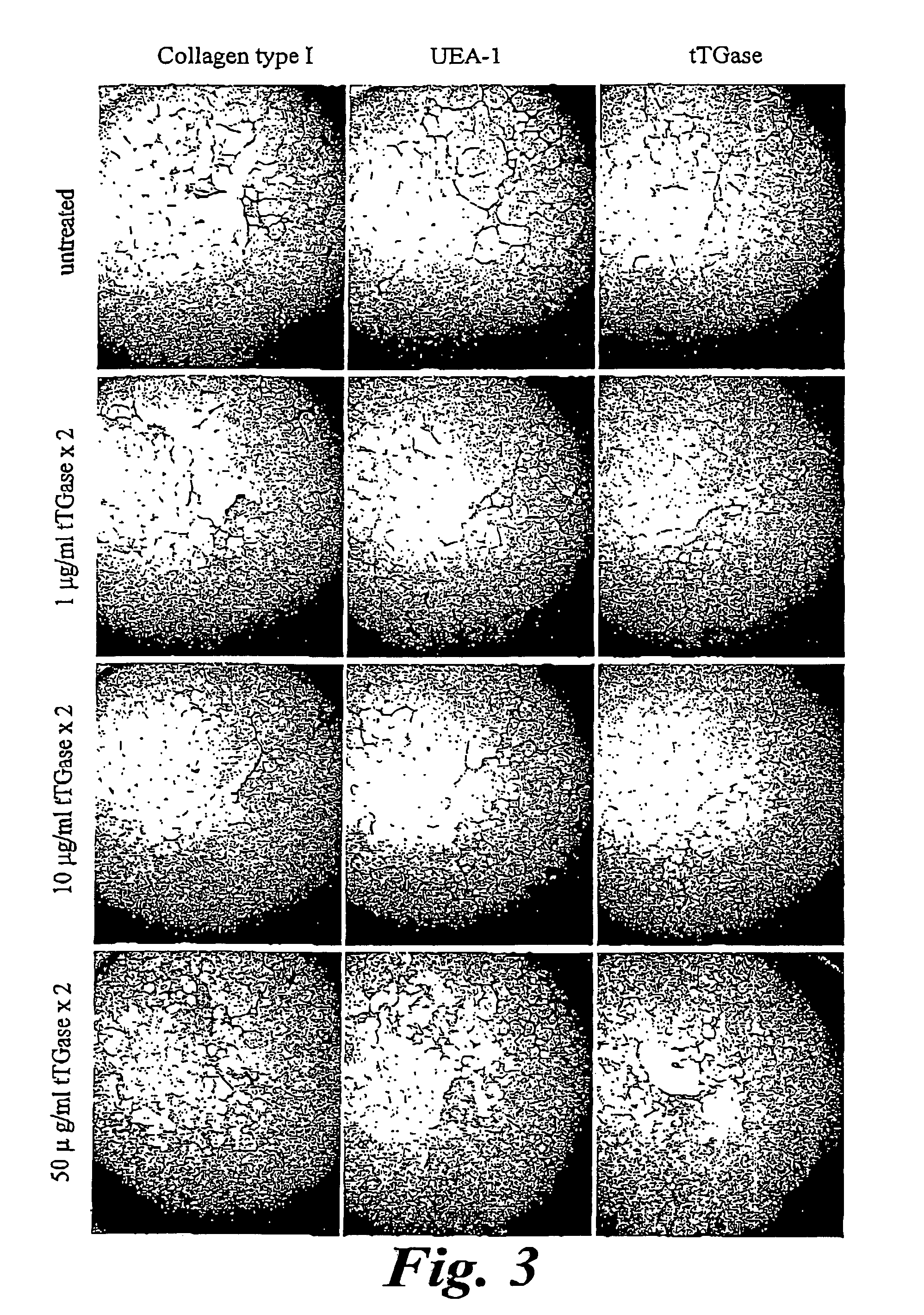Transglutaminase for inhibiting angiogenesis
a technology of angiogenesis and transglutaminase, which is applied in the direction of peptides/protein ingredients, drug compositions, peptides, etc., can solve the problems of poorly understood cell type and biological function
- Summary
- Abstract
- Description
- Claims
- Application Information
AI Technical Summary
Benefits of technology
Problems solved by technology
Method used
Image
Examples
example 1
Inhibition of Angiogenesis In Vitro I—Immunohistochemical Analysis of the Effect of TGase on ECV304 Cells
Materials and Methods
[0149]An in vitro system of angiogenesis / tubulogenesis was developed to evaluate the efficacy of TGase administration on angiogenesis. ECV304 is an endothelial-like cell line resulting from spontaneous mutation that has recently been shown to be epithelial in origin (Brown J., et al., 2000, Lab. Invest. 80:37-45). This cell line exhibits several endothelial cell markers, has the propensity to spontaneously form tubular networks when cultured on Matrigel (Hughes, S. E., 1996, Exp. Cell Res. 225, 171-185), and has been shown to respond to novel and established angiogenic modulators in the same manner as primary human umbilical vein endothelial cells and animal models of angiogenesis (Jian, L., et al., 2000, Nat. Med. 6, 49-55). In the model cell system described below, ECV304 cells were co-cultured with the primary human dermal fibroblast cell line C378 (isolat...
example 2
Inhibition of Angiogenesis In Vitro II—Immunohistochemical Analysis of the Effect of TGase Using a Commercially Available Angiogenesis Assay Kit
Materials and Methods
[0166]The inhibition of angiogenesis following transglutaminase administration was further demonstrated using a commercially available angiogenesis assay kit (Catalogue No ZHA-1000, TCS Biologicals Ltd, Botolph Claydon, Buckinghamshire, UK).
[0167]The kit is supplied as a growing culture of human endothelial cells (together with support cells) in a 24-well plate.
[0168]Angiogenesis was measured using the mnanufacturer's protocol (supplied with the kit).
[0169]In brief, on receipt of the kit from the supplier (day 1) 0.5 ml of fresh media (as supplied with the kit) was added to each well of the plate and the cells were cultured in 5% CO2 (v / v) in a humidified atmosphere at 37° C. Culture media was replaced with fresh stock on days 4, 7 and 9. On day 11, the culture media was removed and cells were fixed by the addition of 1 ...
example 3
Inhibition of Angiogenesis In Vitro III—Western Blot Analysis of the Effect of TGase on Levels of TGase, Fibronectin and Cross-Link Staining
Materials and Methods
[0174]Cells (TCS angiogenesis assay kit) were cultured as described in Examples 1 and 2, and then allocated to one of the following four treatment groups:
(1) Untreated controls;
(2) One dose of 25 μg gplTGase, administered on day 2 after receipt of the kit (cultures are started by the manufacture prior to shipping the kit);
(3) Two doses of 25 μg gplTGase, administered on days 2 and 5;
(4) Four doses of 25 μg gplTGase, adminstered on days 2, 5, 8 and 10.
[0175]Each treatment group (i.e. well) comprises approximately 0.5×106 cells on day 1 and approximately 2×106 cells on day 11.
[0176]On day 11, cells were washed three times in phosphate buffered saline (PBS) pH7.4 and directly solubilised in 150 μl of 2×SDS-PAGE Laemmli sample buffer (Product Code S3401 Sigma)
[0177]Samples were boiled for five minutes and then 10 μl loaded into ...
PUM
| Property | Measurement | Unit |
|---|---|---|
| concentration | aaaaa | aaaaa |
| diameter | aaaaa | aaaaa |
| concentration | aaaaa | aaaaa |
Abstract
Description
Claims
Application Information
 Login to View More
Login to View More - R&D
- Intellectual Property
- Life Sciences
- Materials
- Tech Scout
- Unparalleled Data Quality
- Higher Quality Content
- 60% Fewer Hallucinations
Browse by: Latest US Patents, China's latest patents, Technical Efficacy Thesaurus, Application Domain, Technology Topic, Popular Technical Reports.
© 2025 PatSnap. All rights reserved.Legal|Privacy policy|Modern Slavery Act Transparency Statement|Sitemap|About US| Contact US: help@patsnap.com



